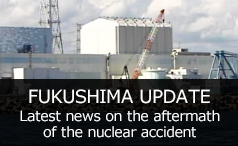Fukushima groundwater released into the ocean
Workers at the Fukushima Daiichi nuclear plant have begun releasing groundwater into the Pacific.
The operation is part of the so-called “bypass plan” to limit the accumulation of contaminated water.
Groundwater flows down from the mountains toward the facility.
It seeps into the basements of the damaged reactor buildings, where it comes into contact with highly radioactive materials.
TEPCO says 300 tons of contaminated water accumulate every day.
The bypass plan involves digging wells and pumping up groundwater before it flows into the reactor buildings.
The water is then held in storage tanks and tested for radiation.
If levels are below official safety standards, it can be discharged into a canal that flows into the ocean.
Workers released 560 tons of water into the ocean on Wednesday morning.
TEPCO officials say tests conducted by a third party confirmed radiation levels were below the safety limit.
Groundwater will be discharged into the ocean once per week.
Officials hope the bypass plan will reduce the accumulation of contaminated water by up to 100 tons per day.


